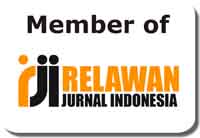Indonesian Tourism Discourse on www.indonesia.travel: Mood Analysis
Abstract
Keywords
Full Text:
PDFReferences
Arab Zouzani, M. A., Pahlavannejad, M. R., and Seyyedi, H. (2019). The investigation of mood and modality in the first letter of nahj elbalagheh based on Halliday’s systemic functional grammar. Global Journal of Foreign Language Teaching, 9(2), 101–109. https://doi.org/10.18844/gjflt.v9i2.3587
Cesiri, D. (2017). Representing Venice’s Local Culture to International Tourists: The Use of the ‘ Languaging ’ Technique in Websites in English. Annali Di Ca’ Foscari. Serie Occidentale, 51, 195–216. https://doi.org/10.14277/2499-1562/AnnOc-51-17-11.
Crăciunescu, A. (2015). Is rebuilding a nation’s international image a question of discourse? The controversial case of Rwanda: A destination of the dark. ANADISS, (19), 101–107.
Depraetere, I., and Reed, S. (2008). Mood and Modality in English. In The Handbook of English Linguistics (pp. 269–290). https://doi.org/10.1002/9780470753002.ch12
Dornyei, Z. (2007). Research Methods in Applied Linguistics: Quantitative, Qualitative, and Mixed Methodologies. Oxford: Oxford University Press Inc.
Fairclough, N. (1995). Critical Discourse Analysis. London: Longman.
Gerot, L., and Wignell, P. (1995). Making Sense of Functional Grammar. Sidney: Gerd Stabler.
Hallet, R. W., and Kaplan-Weinger, J. (2010). Official Tourism Websites: A Discourse Analysis Perspective. Bristol: Short Run Press Ltd.
Ibrahim, N., Shiratuddin, M. F., and Wong, K. (2013). Persuasion Techniques for Tourism Website Design. International Conference on E-Technologies. Bangkok.
Isti’anah, A. (2020). (Re)evaluating language attitudes on Indonesian tourism website: A study on ecolinguistics. Studies in English Language and Education, 7(2), 622–641. https://doi.org/10.24815/siele.v7i2.16683
Jaworski, A., and Pritchard, A. (2005). Discourse, Communication and Tourism. Clevedon: Cromwell Press.
Krisjanous, J. (2016). An exploratory multimodal discourse analysis of dark tourism websites: Communicating issues around contested sites. Journal of Destination Marketing and Management, 5(4), 341–350. https://doi.org/10.1016/j.jdmm.2016.07.005
Kristina, D., and Haryono, T. (2015). Indonesian Online Tourism Promotion: A Rhetorical and Discoursal Look. European Journal of Economics and Business Studies, 3(1), 116–121.
Lamb, G. (2019). Spectacular sea turtles: Circuits of a wildlife ecotourism discourse in Hawai‘i. Applied Linguistics Review, 1–29. https://doi.org/10.1515/applirev-2019-0104
Liping, C. (2017). Mood, Modality and Polarity Analysis of Winston S. Churchill’s Speech on Hitler’s Invasion of the U.S.S.R. Advances in Social Sciences Research Journal, 4(1), 195–202. https://doi.org/10.14738/assrj.41.2625.
Maci, S. M. (2017). Virtual Touring: The Web-Language Of Tourism. 1st International Conference of the Slovene Association of LSP Teachers, 25(July), 41–65. https://doi.org/10.6092/LeF_25_p41
Pane, I. I. I., Saragih, A., Nurlela, N., and Lubis, M. (2018). Doctor-Patient Interaction: A Systemic Functional Analysis. LANGUAGE LITERACY: Journal of Linguistics, Literature, and Language Teaching, 2(2), 135–144. https://doi.org/10.30743/ll.v2i2.780
Pasquini, E. (2018). Politically Correct Tourism Discourse in Airport Websites Guidelines for Inclusive. Scripta Moment, 12, 21–37.
Ping, K., and Lingling, L. (2017). Application of Interpersonal Meaning in Hillary’s and Trump’s Election Speeches. Advances in Language and Literary Studies, 8(6), 28–36. https://doi.org/10.7575/aiac.alls.v.8n.6p.28
Pranita, D. (2018). Digitalization: The Way to Tourism Destination’s Competitive Advantage (Case Study of Indonesia Marine Tourism). The 2nd International Conference on Vocational Higher Education (ICVHE) 2017 “The Importance on Advancing Vocational Education to Meet Contemporary Labor Demands, 243–253.
Salim, M. A., Ibrahim, N. A., and Hassan, H. (2018). Authenticating the Tourist Destination on the Official Tourism Website of Indonesia: Multimodal Perspective. Astra Salvensis - Revista de Istorie Si Cultura, 1, 333–343.
Salim, M. A., and Som, A. P. (2018). Shaping Tourist Destinations through Language and Visual Elements on Tourism Websites: A Tourism Discourse Perspective. International Journal of Engineering and Technology, 7, 364–369.
Samad, Y., Salim, M. A., and Akib, H. (2018). The Functions of Language in Realizing the Indonesian Culinary on the official tourism website of Indonesia: A Tourism Discourse Perspective. IOSR Journal of Humanities and Social Science (IOSR-JHSS), 10(8), 7–15. https://doi.org/10.9790/0837-2310080715
Sumadi, K. (2012). Cultural Capital as the Basis for Developing Tourism at Kuta Traditional Village. Mudra, 3, 315–323.
Talbot, M. (2007). Media Discourse: Representation and Interaction. Edinburgh: Edinburgh University Press Ltd.
Thompson, G. (2014). Introducing Functional Grammar (3rd edition). In New Zealand Studies in Applied Linguistics (3rd ed., Vol. 12). New York: Routledge.
van Dijk, T. A. (2009). Society and Discourse. In Society and Discourse. https://doi.org/10.1017/cbo9780511575273
Webster, J. (2015). Understanding Verbal Art: A Functional Linguistic Approach. London: Springer.
Wodak, R., Meyer, M., and Meyer, M. (2013). Between Theory, Method, and Politics: Positioning of the Approaches to Cda. In Methods of Critical Discourse Analysis. https://doi.org/10.4135/9780857028020.n2
Wu, G. (2018). Official websites as a tourism marketing medium: A contrastive analysis from the perspective of appraisal theory. Journal of Destination Marketing and Management, 10(September), 164–171. https://doi.org/10.1016/j.jdmm.2018.09.004
Yuliana, D., and Imperiani, E. D. (2017). The Realization of Interpersonal Meaning in Course Newsletters: A Systemic Functional Perspective. Indonesian Journal of Applied Linguistics, 7(1), 181–188.
DOI: http://dx.doi.org/10.31332/lkw.v0i0.1850
Copyright (c) 2020 Arina Arina Isti'anah

This work is licensed under a Creative Commons Attribution-ShareAlike 4.0 International License.
Langkawi: Journal of The Association for Arabic and English indexed by:


















.png)
.png)

.png)
2.png)








